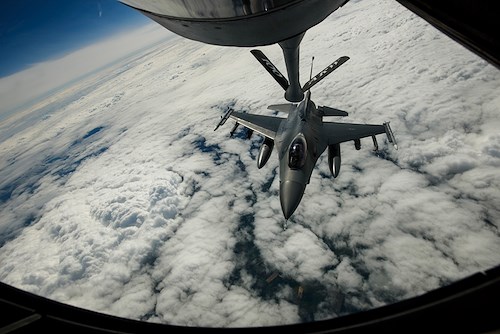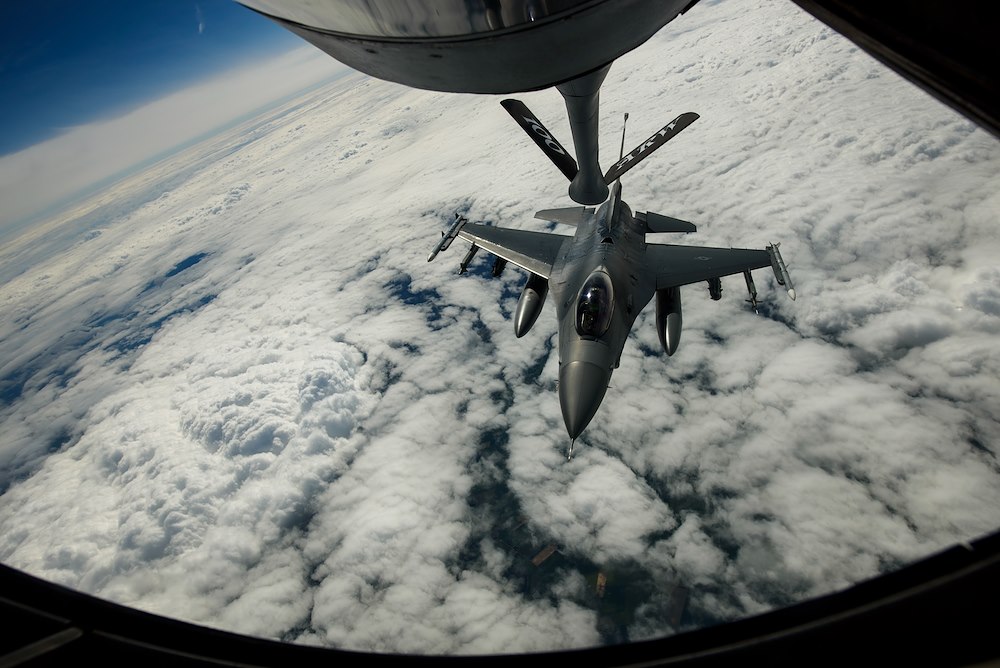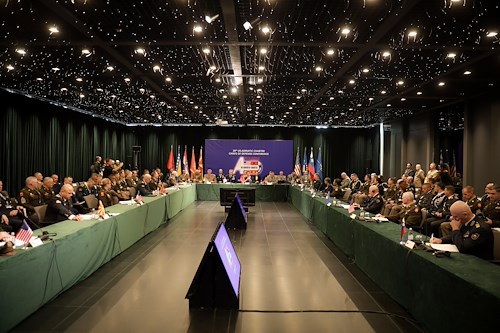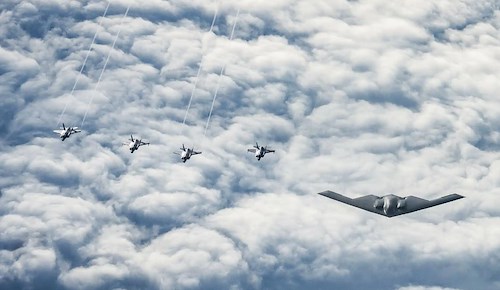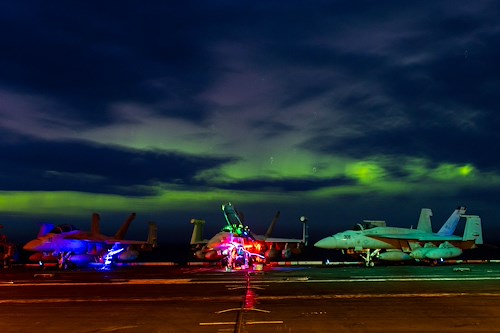Gallery contains 4 images
×
Photo 1 of 4
Air Command and Control plays pivotal role in BALTOPS
An F-16 Fighting Falcon. 510th Fighter Squadron, deployed to Krzesiny Air Base, Poland, in support of Aviation Detachment rotation 17-3, exercise BALTOPS and exercise Saber Strike approaches the boom on a KC-135R Stratotanker over the Baltic Sea, June 13, 2017. BALTOPS is an annually recurring multinational exercise designed to enhance flexibility and interoperability, as well as demonstrate resolve of allied and partner forces to defend the Baltic region. Participating nations include Belgium, Denmark, Estonia, Finland, France, Germany, Latvia, Lithuania, the Netherlands, Norway, Poland, Sweden, the United Kingdom, and the United States. (U.S. Air Force photo by Staff Sgt. Jonathan Snyder)
Photo by: Staff Sgt. Jonathan Snyder
Photo 2 of 4
Air Command and Control plays pivotal role in BALTOPS
Tech. Sgt. Steve Hood, 459th Air Refueling Wing boom operator, part of the Total Force Citizen Airmen team refuels an F-16 Fighting Falcon, 510th Fighter Squadron, from a KC-135R Stratotanker during BALTOPS over the Baltic Sea, June 13, 2017. BALTOPS is an annually recurring multinational exercise designed to enhance flexibility and interoperability, as well as demonstrate resolve of allied and partner forces to defend the Baltic region. Participating nations include Belgium, Denmark, Estonia, Finland, France, Germany, Latvia, Lithuania, the Netherlands, Norway, Poland, Sweden, the United Kingdom, and the United States. (U.S. Air Force photo by Staff Sgt. Jonathan Snyder)
Photo by: Staff Sgt. Jonathan Snyder
Photo 3 of 4
Air Command and Control plays pivotal role in BALTOPS
Polish air force F-16 Fighting Falcons fly in a two ship formation during BALTOPS over the Baltic Sea, June 13, 2017. BALTOPS is an annually recurring multinational exercise designed to enhance flexibility and interoperability, as well as demonstrate resolve of allied and partner forces to defend the Baltic region. Participating nations include Belgium, Denmark, Estonia, Finland, France, Germany, Latvia, Lithuania, the Netherlands, Norway, Poland, Sweden, the United Kingdom, and the United States. (U.S. Air Force photo by Staff Sgt. Jonathan Snyder)
Photo by: Staff Sgt. Jonathan Snyder
Photo 4 of 4
Air Command and Control plays pivotal role in BALTOPS
Capt. Cody Jordan, left, 351st Air Refueling Squadron pilot, conducts a pre-flight inspection on a KC-135R Stratotanker with Master Sgt. Jacob Wavrin, right, 459th Aircraft Maintenance Squadron crew chief, during BALTOPS exercise at Powidz Air Base, Poland, June 12, 2017. The exercise is designed to enhance flexibility and interoperability, to strengthen combined response capabilities, as well as demonstrate resolve among Allied and Partner Nations' forces to ensure stability in, and if necessary defend, the Baltic Sea region. (U.S. Air Force photo by Staff Sgt. Jonathan Snyder)
Photo by: Staff Sgt. Jonathan Snyder
High above the clouds crossing through international airspace, there are more than 50 military aircraft from the U.S. Air Force, Polish air force and German air force training together during the BALTIC OPERATIONS (BALTOPS) and Saber Strike Exercises.
“Within some of the training scenarios we participate in we will fly across three or four sovereign countries with different air traffic control regions,” said U.S. Air Force Lt. Col. Benjamin Freeborn, 510th Fighter Squadron commander, Aviano Air Base, Italy. “Sometimes we operate outside the range of the base and we can’t come back to it without that aerial refueling support.”
The individuals behind the scenes ensuring day-to-day operations take place are located at the Combined Air Operations Centre Uedem (CAOCU), Germany. It is here where Air Command and Control (Air C2) is taking place. BALTOPS includes a number of realistic scenarios that test our combined interoperability, to include the coordination of aerial refueling spots to simulated Close Air Support (CAS), from air interdiction to supporting NATO and NATO Partner ships at sea.
“The amount of orchestration involved to have a flight of F-16’s connect with a tanker for fuel without talking to each other until we show up is immense, it’s certainly like a leap of faith in the Air C2 to make it happen,” said Freeborn. “If any of those links in the chain breaks, we would be forced to divert and possibly land on an unfamiliar airfield.”
Another important link in the Air C2 chain is the Joint Interface Control Officer (JICO). The JICO manages the Tactical Data Link, which includes a newly developed Link 16 Network and some critical connections to support the CAOCU.
“My role is to design the Tactical Data Link (TDL) architecture, which consists of finding ways for Data Link capable ships, aircraft and shore components to connect to each other using Link 11, Link 16 and Joint Range Extension And Protocol (JREAP),” said U.S. Navy Lt. Ryan Cornforth, Naval Forces Europe/Africa Sixth Fleet JICO. “The result from connecting the participants allows the Commanders to execute C2 from a common tactical picture.”
CAOCU, is responsible for NATO Air Policing north of the Alps and CAOC Torrejon for the south. Each of them has a Static Air Defense Center, conducting 24/7 peacetime Air Policing, and a Deployable Air Operations Center for operational contingency tasks such as providing qualified personnel augmentation to the NATO Command Structure Joint Force Air Component at Ramstein Air Base, Germany.
“CAOCU has been able to provide that linkage to the national airspace systems and eurocontrol, which is responsible for the civilian air traffic to ensure de-confliction,” said U.S. Navy Cmrd. Ed Chandler, BALTOPS Air EXCON director. “The Air C2 has been running a 24/7 operations and planning floor just for BALTOPS.”
For Air Policing, CAOCU closely cooperates with Control and Reporting Centers and National Air Policing Centers, allowing for thorough coordination of peacetime Air Policing operations, procedures and command and control. This includes control of NATO’s Baltic Air Policing operation, where contributing nations take turns in providing Quick Reaction Alert forces for the mission.
“This year is unique as we are employing a newly developed Link 16 Network,” said Cornforth. “The new network includes advanced capabilities in many areas and has been developed to meet future requirements; we are sending real-time Baltic pictures to the CAOCU for the first time ever!”
Even though BALTOPS is a U.S. sponsored exercise, it is led by Striking and Support Forces NATO (STRIKFORNATO) and supported by NATO Air Command (AIRCOM), and brings together both NATO and NATO partner countries to increase interoperability.

